Auto Semi Minolta
The Auto Semi Minolta (オート・セミ・ミノルタ) is a Japanese 4.5×6 folding rangefinder camera, released in 1937 and available at least until 1943.[1] It was made by Chiyoda Kōgaku (the predecessor of Minolta) and distributed by Asanuma Shōkai. This camera was inspired by the Weltur; it is completely different from the viewfinder Semi Minolta (I) and II, with which it only shares a few parts.
Contents
Description
The body of the Auto Semi Minolta is largely copied from the Welta Weltur, in particular the folding struts and the focusing system are identical. The focusing is controlled by a small knob placed on the right of the folding bed, moving the whole lens and shutter assembly (unit focusing).

|
| (Image rights) |
The range- and viewfinder is contained under a top housing, whose shape is again inspired by the Weltur. Both devices are combined and share the same eyepiece at the right end of the camera. The Auto Semi Minolta was certainly the first serial-produced Japanese camera to have a combined range and viewfinder, only preceded by the Olympus Standard and perhaps the Lord prototypes.
The name Minolta is engraved between the rectangular viewfinder window and the round rangefinder window. The same Minolta engraving is present on a small black plate inside the folding bed, covering the focusing mechanism. Above the top housing there is an Auto Semi engraving, the serial number and an accessory shoe. The front leather is embossed Minolta.
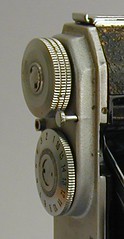
|

| |

| ||
| Film advance mechanism, with close-ups of the unlock button and folding bed release. (Image rights) |
||
The Auto Semi Minolta has an automatic film advance device inspired by Plaubel products like the Roll-Op folder or the rollfilm backs of the Plaubel Makina. It is placed in a housing at the right end of the bottom plate, near the back latch. This housing supports a big advance knob and a large and thin exposure counter disc, with 1 to 16 graduations facing a red-dotted index. On the back, there is a sliding button to unlock film advance, and the same housing also supports the folding bed release. The case of the Auto Semi Minolta has a flap to cover the advance knob and exposure counter.[2]

|
| Back view. (Image rights) |
The tripod screw is located at the opposite end of the bottom plate. The back is hinged to the left, with a red window protected by a vertically sliding cover at the top left, only used to position the film for the first exposure. The film chamber contains two pivoting cradles, one on each side, maintaining the film spools in place.
 
|
| Lens scheme and rangefinder mechanism, from the July 1938 catalogue by Asanuma Shōkai. (Image rights) |
The lens is a unit-focused four-element Promar 75mm f/3.5 on all the cameras, the same lens as on the Minoltaflex (I). It was made by Asahi Kōgaku (predecessor of Pentax), which also made the three-element Coronar lens of the Semi Minolta.[3] The aperture scale is always screwed to the bottom of the shutter plate.
Evolution
The Auto Semi Minolta somewhat evolved during its production run. The shutter was first a Compur (T, B, 1–250) then a Crown-Rapid (T, B, 1–400) in #0 size, made by Chiyoda itself. The latter is a down-sized version of the shutter made for the Auto Press Minolta. The use of an imported Compur on the early cameras perhaps indicates that the small Crown-Rapid was not yet ready for production when the camera was released. The shutter is normally not synchronized on either version, but some examples are found with a non original synch post.[4]
Compur shutter
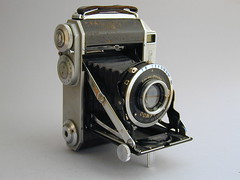  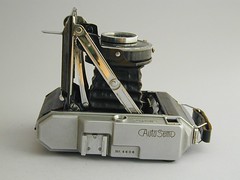
|
| Auto Semi Minolta no.4606, Promar Anastigmat Nippon f/4.5 lens, Compur shutter, early back latch. Pictures courtesy of eBayer hbpartner. (Image rights) |
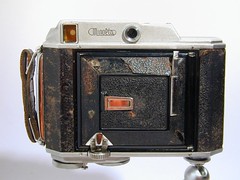
|
| Front view showing the peculiar shutter release. Pictures courtesy of eBayer hbpartner. (Image rights) |
On the first version, the shutter is a Compur S with T, B, 1–250 speeds and a self-timer, and the shutter release is on the folding bed. The shutter plate has the usual engravings: Deckel-München at the top and COMPUR at the bottom, with an FD logo (for Friedrich Deckel) on the right. The advance knob has a convex top and a single row of grooves.
The camera was announced in late 1937:[5] it was advertised in Asahi Camera in October and was featured in the new products column of the November issue of the magazine.[6] It was displayed together with the Minoltaflex and Auto Press Minolta at the show organized in December 1937 in the Tōkyō Kaikan by Chiyoda Kōgaku Seikō and Asanuma Shōkai to celebrate their new commercial agreements.[7] Pictures of the first version with Compur shutter appear in advertisements dated October 1937 to March 1938 and perhaps later.[8] The price appears as ¥195 from November 1937 onwards, making the Auto Semi Minolta one of the most expensive Japanese cameras of the time.
Examples of the first version are known with body numbers from 4039 to 4606 and lens numbers from 32889 to 34379.
Crown shutter
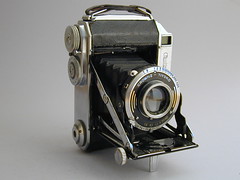  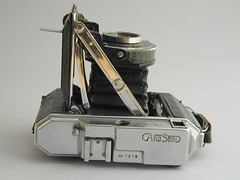
|
| Auto Semi Minolta no.7208, Promar Anastigmat Nippon f/4.5 lens, Crown shutter, early back latch. The self-timer control is certainly broken. Pictures courtesy of eBayer hbpartner. (Image rights) |
The second version has a Crown shutter giving T, B, 1–400 speeds. The shutter release has moved to the top plate, above the hinge of the folding bed. The shutter is inconsistently called "Crown II", "Crown RS" (presumably for "Rapid Shutter" or Rapid with Self-timer") or "Crown Rapid II" in the original documents. It is externally a copy of the Compur-Rapid and it is probable that the mechanism is too. The speed rim is engraved CROWN–RAPID and the shutter plate is marked CROWNII–TIYOKO at the top. (Tiyoko is an alternate writing for Chiyoko, itself an abbreviation of the company name Chiyoda Kōgaku.) There is a self-timer exactly similar to the one mounted on the Compur, whose control lever is sometimes broken on the examples found today (including the one pictured in this page).[9]
 
|
| Advance knob, old and new type. (Image rights) |
The earliest examples have the same type of advance knob as on the previous version; body numbers are known from 5487 to 6447 and lens numbers from 37408 to 40598.[10] Most cameras have a new type of advance knob with a flatter top and three grooved rows; body numbers are known from 7208 to 10867 and lens numbers from 38544 to 62865. Minor variations are known in the folding bed release button (striated or flat tip) but they perhaps occurred independently.
One isolated camera has been observed with a Crown II shutter giving T, B, 1–250 speeds only, and lacking the CROWN–RAPID engraving on the rim;[11] this might correspond to a very early version of the shutter.
 
|
| Supply spool cradle, old and new type. (Image rights) |
Inside the cameras with Crown shutter, the cradle for the supply spool is different from the corresponding part in the Compur model. It also seems that the actual size of the picture frame was slightly reduced (from 44×58mm to 43×57mm). It would be further reduced on later examples, to 42×55mm. It is possible that edge sharpness was considered insufficient and that the image size was slightly cropped as a result.
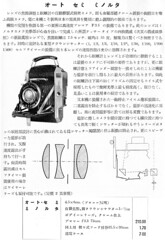
|
| Auto Semi Minolta in the July 1938 catalogue and price list by Asanuma Shōkai. Scan by A. Apra. (Image rights) |

|
| Auto Semi Minolta in the October 1941 catalogue by Asanuma Shōkai. (Image rights) |
The July 1938 catalogue by Asanuma Shōkai shows the new version with Crown shutter, priced at ¥210.[12] The same version appears in advertisements until December 1940 and perhaps later, and in the catalogue by Asanuma Shōkai dated October 1941.[13] The price rose to ¥255 by mid-1939.[14] It was officially set to ¥248 by early 1941, and to ¥290 by late 1941.[15]
New back latch
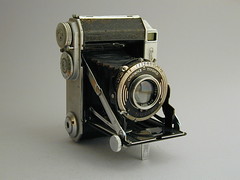  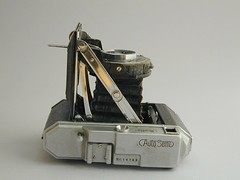
|
| Auto Semi Minolta no.14792, Promar Nippon f/4.5 lens, Crown shutter, self-timer, late back latch. The shutter's synch post is probably not original. Pictures courtesy of eBayer hbpartner. (Image rights) |

|

|
| Back latch, old and new type (seen from behind). (Image rights) |
The third version has a modified back opening and no holding strap. These parts were presumably modified in late 1941, some time after the back latch of the Semi Minolta II, and this version is pictured in an advertisement dated March 1942, showing an unchanged price at ¥290.[16]
This version is known with body numbers from 12492 to 15069 and lens numbers from 613x0 to 91286. The engraving on the lens rim was switched from Promar Anastigmat Nippon to Promar Nippon, at some time between lens no.72972 and no.82583. (A similar change occurred on the Semi Minolta II.)
The CROWN–RAPID engraving on the speed rim is absent on very late examples, with the last lens numbers in the 912xx range. This marking change is notably visible on body no.14792 pictured above; it certainly corresponds to the last shutter units produced, perhaps because they were hastily assembled in difficult wartime conditions.[17]
The Auto Semi Minolta still appears in the government inquiry listing Japanese camera production as of April 1943;[18] this is the last known mention of the camera.
Accessories
The July 1938 and October 1941 catalogues by Asanuma Shōkai list the following accessories:[19]
- hood with filter holder (30mm diameter): ¥1.70 in 1938 and 1941;
- all chrome hood with filter holder: ¥3.50 in 1941 only;
- prism reflex finder (プリズム反射ファインダー): ¥21.35 in 1941 only;
- case: ¥7 in 1938, ¥13.04 in 1941.
The all-chrome hood has a round shape and the Auto Semi logo at the top, and comes in a small leather case. The regular hood is probably black, and is perhaps not specific to the Auto Semi Minolta: generic hoods holding 30mm diameter filters are offered for the same price of ¥1.70 elsewhere in the same catalogues. Little is known on the prism reflex finder, of which no picture has yet been observed.
The ever-ready case is made of brown leather; it has either the Auto Semi logo or the full name Auto Semi Minolta embossed at the front.
Production
The Auto Semi Minolta was produced in the Mukogawa (武庫川) plant, together with the other bellows models, at a rate of about 250 units per month around 1938.[20]
Body numbers for the Auto Semi Minolta have been observed or reported from 4039 to 15069. The collected data is not homogeneous and contains some gaps, but examples are known in the 4xxx, 5xxx, 6xxx, 7xxx, 8xxx, 10xxx, 12xxx, 13xxx, 14xxx and 15xxx ranges. The sequence was certainly specific to the camera, and perhaps started at 4000. We can make a reasonable estimate for the total production at 11,000 units, in a single batch from c.4000 to c.15000, but we cannot discard the possibility that several batches were made.
Notes
- ↑ Dates: the advertisements and articles listed in Kokusan kamera no rekishi, p.342, run from 1937 to 1942, and the camera was still mentioned in the "Kokusan shashinki no genjōchōsa" ("Inquiry into Japanese cameras") compiled in April 1943 (item 51).
- ↑ Formerly visible on pictures in a page at With Zakka.
- ↑ "Kokusan shashinki no genjōchōsa" ("Inquiry into Japanese cameras"), lens item Lb39; Lewis, p.182.
- ↑ Francesch, p.81, says that a magnesic flash was sold as an accessory but this is certainly a confusion with the Auto Press Minolta.
- ↑ The fifty-year history Minolta 50-nen no ayumi, p.65, says September 1937, but the exact month is unconfirmed.
- ↑ Kokusan kamera no rekishi, p.342. The advertisement in Asahi Camera October 1937 is reproduced in Tanimura, p.12 of Camera Collectors' News no.118 and p.21 of Kurashikku Kamera Senka no.12.
- ↑ Tashima Gizō, interviewed by Saeki Kakugorō on p.77 of Kurashikku Kamera Senka no.12, says November 1937, but Awano, p.7 of the same magazine, specifies that the show was inaugurated on December 12, 1937.
- ↑ Advertisement in Asahi Camera October 1937 reproduced in Tanimura, p.12 of Camera Collectors' News no.118 and p.21 of Kurashikku Kamera Senka no.12; advertisement in Asahi Camera November 1937 reproduced in Kokusan kamera no rekishi, p.97; advertisement in Asahi Camera January 1938 reproduced in Tanimura, p.15 of Camera Collectors' News no.118; March 1938 advertisement in Asahi Graph March 23, 1938 formerly reproduced in Gochamaze (archived). The shutter type is sometimes faintly recognizable.
- ↑ Something similar might occur with the exposure counter index. Tanimura says in Camera Collectors' News no.118 that the Crown model has a black painted dot instead of the protruding red-dotted pin, but it seems that the part is actually missing in the example pictured and that the black dot is the attaching hole.
- ↑ Examples observed in online auctions. See also the example pictured in the 70th anniversary poster reproduced in Photoclub Alpha and in other websites copying the same picture.
- ↑ Example pictured in a Chinese website.
- ↑ July 1938 catalogue by Asanuma Shōkai, pp.2–3, and corresponding price list, p.2.
- ↑ Advertisement in Asahi Graph January 5, 1939 (the shutter type is faintly recognizable), and advertisement in Asahi Graph July 26, 1939, formerly reproduced in Gochamaze (archived); advertisement in Asahi Camera November 1939 reproduced in Kokusan kamera no rekishi, p.98; advertisement in Asahi Graph April 17, 1940 formerly reproduced in Gochamaze (archived); advertisement in Shashin Shinpō December 1940, reproduced in Hagiya, p.10 of Kurashikku Kamera Senka no.12; catalogue Shashinki to zairyō by Asanuma Shōkai, dated October 1941, p.12.
- ↑ Advertisement in Asahi Graph July 26, 1939, formerly reproduced in Gochamaze (archived).
- ↑ ¥248: "Kokusan shashinki no kōtei kakaku", type 3, section 9. ¥290: catalogue Shashinki to zairyō by Asanuma Shōkai, dated October 1941, p.12.
- ↑ Advertisement in Hōdō Shashin March 1942 reproduced in Kokusan kamera no rekishi, p.98. Another advertisement probably dated 1942 is reproduced in Nostalgic Camera by Toshio Inamura.
- ↑ A picture of another camera (no.147xx) has been observed with different incomplete markings: it has the CROWN–RAPID engraving on the speed rim but the CROWNII and TIYOKO markings are absent on the front plate (only the intermediate hyphen is visible), and the word Nippon and part of the aperture 1:3.5 are absent on the lens bezel. It is unclear if this isolated picture is a fake obtained with an image manipulation program, or depicts a camera which actually left the factory with unfinished markings.
- ↑ "Kokusan shashinki no genjōchōsa" ("Inquiry into Japanese cameras"), item 51.
- ↑ Catalogues by Asanuma Shōkai, dated July 1938, p.3, and October 1941, p.12.
- ↑ Mukogawa plant: Awano, p.7 of Kurashikku Kamera Senka no.12. Monthly production: Tashima Gizō, interviewed by Saeki Kakugorō on p.78 of Kurashikku Kamera Senka no.12.
Bibliography
Original documents
- Asanuma Shōkai. Cameras — All other apparatus and materials — 1938. Catalogue dated July 1938, pp.2–3, and corresponding price list, p.2. Documents partly reproduced in this Flickr album by Rebollo_fr.
- Asanuma Shōkai. Shashinki to zairyō (写真機と材料, Cameras and supplies). Catalogue dated October 1941, p.12. Document partly reproduced in this Flickr album by Rebollo_fr.
- "Kamera no kōtei kakaku kanpō happyō" (カメラの公定価格官報発表, Official announcement of the set prices of the cameras), November 1941. Extract of a table listing Japanese camera production and setting the retail prices, reproduced in "Bebī Semi Fāsuto 'Kore ha bebī wo nanotta semi-ki da'" (ベビーセミファースト"これはベビーを名乗ったセミ機だ", Baby Semi First, 'this is a Semi camera called Baby'), an article by Furukawa Yasuo (古川保男) in Camera Collectors' News no. 277 (July 2000). Nishinomiya: Camera Collectors News-sha. P. 27. Type 3, section 9.
- "Kokusan shashinki no genjōchōsa" (国産写真機ノ現状調査, Inquiry into Japanese cameras), listing Japanese camera production as of April 1943. Reproduced in Supuringu kamera de ikou: Zen 69 kishu no shōkai to tsukaikata (スプリングカメラでいこう: 全69機種の紹介と使い方, Let's try spring cameras: Presentation and use of 69 machines). Tokyo: Shashinkogyo Syuppan-sha, 2004. ISBN 4-87956-072-3. Pp.180–7. Item 51.
- "Kokusan shashinki no kōtei kakaku" (国産写真機の公定価格, Set prices of the Japanese cameras), listing Japanese camera production as of October 25, 1940 and setting the retail prices from December 10, 1940. Published in Asahi Camera January 1941 and reproduced in Shōwa 10—40nen kōkoku ni miru kokusan kamera no rekishi (昭和10〜40年広告にみる国産カメラの歴史, Japanese camera history as seen in advertisements, 1935—1965). Tokyo: Asahi Shinbunsha, 1994. ISBN 4-02-330312-7. Pp.108—9. Type 3, section 9.
Older historical accounts
- Minolta Camera. Minolta 50-nen no ayumi (Minolta・50年のあゆみ, Minolta 50-year history). November 1978. Pp.6 and 65.
- Shashin Kōgyō no.77 (September 1958). "Hensen kamera ichiran-pyō" (変遷カメラ一らん表, Table of camera evolution.) P.295. (This is a chronology of Minolta cameras from the Nifcarette onwards. This document is reproduced in this Flickr page by Rebollo_fr.)
- Taniguchi Masao (谷口匡男), from the commercial department (営業部) of Chiyoda Kōgaku Seikō. "Minoruta kamera no sakujitsu, konnichi" (ミノルタ・カメラの昨日、今日, Minolta cameras, yesterday and today). In Shashin Kōgyō no.77 (September 1958). Pp.275–9.
Recent sources
- Asahi Camera (アサヒカメラ) editorial staff. Shōwa 10–40nen kōkoku ni miru kokusan kamera no rekishi (昭和10–40年広告にみる国産カメラの歴史, Japanese camera history as seen in advertisements, 1935–1965). Tokyo: Asahi Shinbunsha, 1994. ISBN 4-02-330312-7. Item 275. (See also the pictures on pp.11 and 425.)
- Awano Mikio (粟野幹男). "Minoruta ryakushi" (ミノルタ略史, "Minolta short history"). Kamera Rebyū: Kurashikku Kamera Senka (カメラレビュー クラシックカメラ専科) / Camera Review: All about Historical Cameras no.12, October 1988. No ISBN number. Minoruta kamera no subete (ミノルタカメラのすべて, special issue on Minolta). Pp.6–8.
- Francesch, Dominique and Jean-Paul. Histoire de l'appareil photographique Minolta de 1929 à 1985. Paris: Dessain et Tolra, 1985. ISBN 2-249-27685-4. Pp.24 and 81.
- Fujioka Shunichirō (藤岡俊一郎). "<Ōto semi minoruta> bunkai-ki" (<オートセミミノルタ>分解記, "'Auto Semi Minolta' dismantling notes"). Kamera Rebyū: Kurashikku Kamera Senka (カメラレビュー クラシックカメラ専科) / Camera Review: All about Historical Cameras no.76, June 2005. ISBN 4-257-13078-4. Kurashikku kamera katachi to kinō 'supuringu kamera hen' (クラシックカメラ形と機能「スプリングカメラ編」, special issue on spring cameras). Pp.116–21.
- Hagiya Takeshi (萩谷剛). "Kōkoku ni miru Minolta kamera no rekishi" (広告に見るミノルタカメラの歴史, "Minolta camera history seen through the advertisements"). Kamera Rebyū: Kurashikku Kamera Senka (カメラレビュー クラシックカメラ専科) / Camera Review: All about Historical Cameras no.12, October 1988. No ISBN number. Minoruta kamera no subete (ミノルタカメラのすべて, special issue on Minolta). Pp.9–12.
- The Japanese Historical Camera. 日本の歴史的カメラ (Nihon no rekishiteki kamera). 2nd ed. Tokyo: JCII Camera Museum, 2004. P.32.
- Lewis, Gordon, ed. The History of the Japanese Camera. Rochester, N.Y.: George Eastman House, International Museum of Photography & Film, 1991. ISBN 0-935398-17-1 (paper), 0-935398-16-3 (hard). Pp.54 and 182.
- McKeown, James M. and Joan C. McKeown's Price Guide to Antique and Classic Cameras, 12th Edition, 2005-2006. USA, Centennial Photo Service, 2004. ISBN 0-931838-40-1 (hardcover). ISBN 0-931838-41-X (softcover). P.672.
- Omoide no supuringu-kamera-ten (思い出のスプリングカメラ展, Exhibition of beloved self-erecting cameras). Tokyo: JCII Camera Museum, 1992. (Exhibition catalogue, no ISBN number.) P.9.
- Saeki Kakugorō (佐伯恪五郎). "Tashima Gizō-shi ni kiku" (田嶋義三氏に聞く, "Asking Tashima Gizō"). Kamera Rebyū: Kurashikku Kamera Senka (カメラレビュー クラシックカメラ専科) / Camera Review: All about Historical Cameras no.12, October 1988. No ISBN number. Minoruta kamera no subete (ミノルタカメラのすべて, special issue on Minolta). Pp.76–9.
- Scheibel, Anni Rita and Joseph. 70 Jahre Minolta Kameratechnik — Von der Nifcalette bis zur Dynax 9. Stuttgart: Lindemanns Verlag, 3rd edition, 1999. ISBN 3-89506-191-3. Pp.24–5.
- Sugiyama, Kōichi (杉山浩一); Naoi, Hiroaki (直井浩明); Bullock, John R. The Collector's Guide to Japanese Cameras. 国産カメラ図鑑 (Kokusan kamera zukan). Tokyo: Asahi Sonorama, 1985. ISBN 4-257-03187-5. Items 1205–1206.
- Tanimura Yoshihiko (谷村吉彦). "Supuringu kamera <semi minoruta>" (スプリングカメラ<セミミノルタ>, "'Semi Minolta' self-erecting camera"). Kamera Rebyū: Kurashikku Kamera Senka (カメラレビュー クラシックカメラ専科) / Camera Review: All about Historical Cameras no.12, October 1988. No ISBN number. Minoruta kamera no subete (ミノルタカメラのすべて, special issue on Minolta). Pp.19–24.
- Tanimura Yoshihiko (谷村吉彦). "Semi Minolta I-gata to II-gata (sono 2)." (セミミノルタⅠ型とⅡ型(その2), "Semi Minolta I and II (part 2)") In Camera Collectors' News no.118 (April 1987). Nishinomiya: Camera Collectors News-sha.
Links
General links
In English:
- Auto Semi Minolta in the 70th anniversary Minolta poster, reproduced at Photoclub Alpha
In German:
- Auto Semi Minolta at Fotonexus (archived)
In Japanese:
- Auto Semi Minolta and more pictures in Miyazawa Noriyuki's camera site
- Auto Semi Minolta in the Camera database of the Center of the History of Japanese Industrial Technology
- Auto Semi Minolta in the Map Camera Museum (archived)
Original documents
In Japanese:
- Advertisement for the Auto Semi Minolta published between 1942 and 1945, reproduced in Nostalgic Camera by Toshio Inamura.
| Nifca, Molta and Chiyoda prewar and wartime cameras () | |
|---|---|
| folding plate cameras | |
| Nifcaklapp | Nifcasport | Sirius | Arcadia | Lomax | Eaton | Happy | |
| folding rollfilm cameras | telescopic bakelite cameras |
| Nifcarette | Sirius Bebe | Semi Minolta | Auto Semi Minolta | Minolta Vest | Baby Minolta | Minolta Six |
| strut-folding cameras | TLR cameras |
| Nifca-Dox | Minolta | Auto Minolta | Auto Press Minolta | Minoltaflex | Minoltaflex Automat | Minoltaflex military prototype |